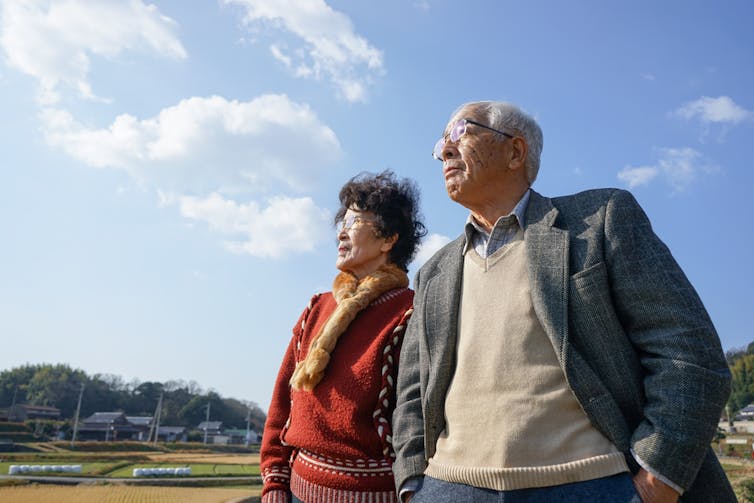Our calculator will guess how many healthy years of life you have left
How many healthy years of life do you have ahead before you become unhealthy – and then die? One model tries to find the answer.

As the old saying goes, the only things certain in life are death and taxes. While death is inevitable, the quality of life you experience until death is often within an individual’s control.
This is what our team at the Goldenson Center for Actuarial Research chose to focus on by developing a rigorous measure of quality of life. How many healthy years of life do you have ahead before you become unhealthy?
Everyone understands the benefits of living a long healthy life, but this also has implications for industry and society. Medical costs, financial planning and health support services are directly related to the state of health of an individual or community.
We call this measure of quality of life “healthy life expectancy” and its complement “unhealthy life expectancy.” We define entering an unhealthy state as a severe enough state of disablement that there is no recovery, so you remain unhealthy until death.
It follows that life expectancy – a measure of the total future years an individual is expected to live – is simply the two added together.
Calculating
Imagine a healthy 60-year-old male who exercises regularly, has a healthy diet and healthy body mass index and sleeps at least eight hours a night. By our estimate, he could have an additional 13 years of healthy living compared to his unhealthy counterpart. That’s 13 more years of quality living with family and loved ones.
This is quite a startling revelation, not only because of the significant difference in healthy life expectancy between these two individuals, but also because this difference is driven by lifestyle choices within the individual’s control.
So what factors contribute to a better healthy life expectancy? Two factors that are not lifestyle-related are age and gender. All other things being equal, healthy life expectancy decreases with age. Women have a longer healthy life expectancy compared to men.
We have already seen that diet, exercise and sufficient sleep positively impact healthy life expectancy. Other positive factors that we have incorporated in our model include level of education, level of income, perception of one’s own state of health, moderate alcohol intake, not smoking and absence of Type 2 diabetes. The higher the level of education and income, the higher your healthy life expectancy. Having a positive perception of your state of health helps, too.
Try it yourself
Want to know your own estimate of healthy years ahead? We developed a free online tool that lets you calculate healthy, unhealthy and total life expectancy. This is work in progress.
This is the first time such a measurement tool has been developed. While it’s too early to validate the accuracy of our calculations with actual data, we have been careful to ensure that the model assumptions are based on established actuarial sources and the modeling results are logical and consistent.
It should be noted that healthy life expectancy is simply an educated prediction. Unforeseen incidents – like being hit by a truck – could render this estimate invalid, no matter how well you manage lifestyle habits. Also, there could be other nonmeasurable factors impacting healthy life expectancy that we have not included in our model, like level of stress, a positive attitude to life or social connections.

Putting our model to work
Our team plans to explore some of these practical applications of healthy life expectancy in industry.
For example, the concept of healthy life expectancy can help with retirement financial planning. Annual retirement spending should not be level across your life expectancy. More discretionary retirement spending should happen during healthy years and less during unhealthy years, while spending on basic expenses increases during unhealthy years.
Insurance products can be also designed using healthy life expectancy measures in mind. This can protect an individual against additional basic living expenses during the unhealthy period. One such product could be a deferred long-term care or temporary deferred life annuity, where the deferral period is for healthy life expectancy and the temporary coverage is for the unhealthy period. This can be a significantly cheaper and a more needed product compared to what is available in the marketplace currently.
Since healthy life expectancy is also related to quality of life and level of health, a relative index could compare an individual’s results against a benchmark healthy life expectancy for someone with “average” characteristics. This can then be used as an underwriting tool and to predict future health care costs. Our model could also serve as a patient screening tool for medical providers by incorporating more detailed lifestyle and dietary details as well as prior medical history information.
We hope that other researchers and practitioners will continue to build on this. Then society could focus on not just prolonging life, but prolonging quality of life using our model. As President Abraham Lincoln once said, “In the end, it is not the years in your life that count. It’s the life in your years.”
Jeyaraj Vadiveloo does not work for, consult, own shares in or receive funding from any company or organization that would benefit from this article, and has disclosed no relevant affiliations beyond their academic appointment.
Read These Next
The Bible says little about Jesus’ childhood – but that didn’t stop medieval Christians from enjoyin
Legends about Jesus’ early years that circulated in medieval Europe often drew on apocryphal texts.
Data centers need electricity fast, but utilities need years to build power plants – who should pay?
How many data centers will be built – and how much electricity they’ll need – is uncertain. Being…
Sleep problems and depression can be a vicious cycle, especially during pregnancy − here’s why it’s
Inadequate sleep can have negative downstream effects on everyday cognitive functioning and mental health,…






